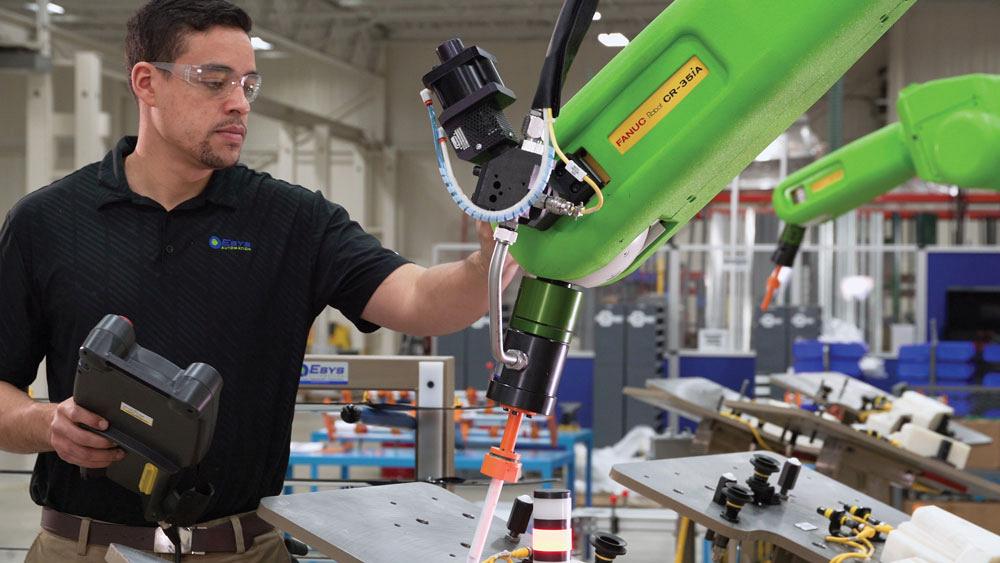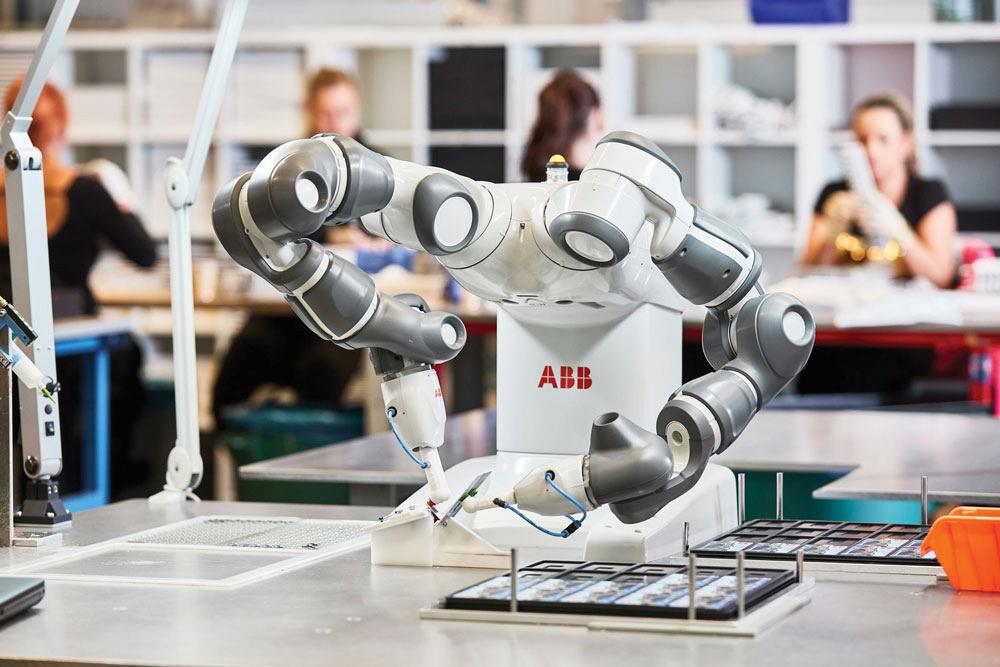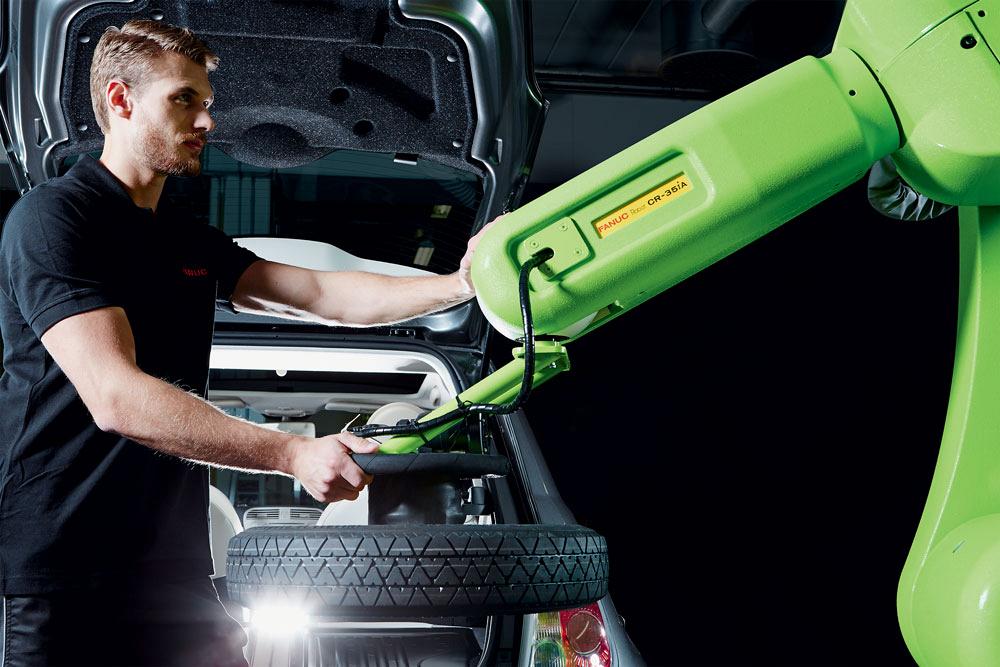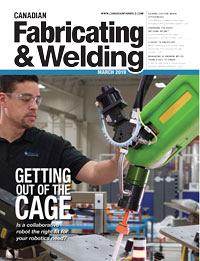Editor
- FMA
- The Fabricator
- FABTECH
- Canadian Metalworking
Cobot or not?
Is a collaborative robot the right fit for your robotics need?
- By Rob Colman
- March 20, 2019
- Article
- Automation and Software

A FANUC Collaborative Robot System is used for applying urethane to automotive glass. Image courtesy of FANUC ? ESYS Automation.
Collaborative robots have caught the imagination of many shop owners over the past couple years as the sophistication of the technology has developed and the comfort of many with robotics in general has improved.
The idea of a safe robotic tool that can be used without protective fencing is, of course, appealing. Less fencing in a shop means more usable space on a shop floor. It also expands the variety of applications for which a robot can be considered a viable tool.
“It used to be that if you couldn’t automate the entire process, you couldn’t automate that process at all,” said Joe Campbell, senior manager, strategic marketing and application development for Universal Robots North America. “Now you can automate a portion of the process and the manufacturer still benefits because taking care of that part of the process improves quality or reduces labour. It means that automation that wasn’t a possibility 10 years ago now is an option.”
However, it’s important to understand precisely what a collaborative robot is and what it is not. While this new technology is engaging and interesting, it isn’t the right fit for all jobs.
What Is a Collaborative Robot?
The most basic definition of a collaborative robot (cobot) is “a person and a robot sharing a common workspace,” but as Dale Arndt, director of engineering and integration at FANUC Canada, noted, ISO standard 10218 and the CSA Z434 go on to say that the robot will have “features specifically designed for collaborative operation.” It’s worth enumerating what makes such a robot different from others. Cobots are equipped with at least one of the following technologies:
1. Safety-rated monitored stop. “This typically refers to a robot detecting a worker’s presence and stopping when the worker is in the collaborative space,” said Arndt.
2. Hand-guided control. With this technology, the worker can hold the robot and guide it through the work. “In the FANUC world, lift assist applications may work in this mode with robots,” said Arndt.
3. Speed and separation monitoring. This typically refers to a sensor detecting the distance between the robot and the employee and works either faster or slower or stops depending on how close the person is.
4. Power and force limiting by inherent design or control. This technology means that no matter what happens, the robot will stop safely when it touches a coworker or the coworker touches the robot.

Cobots can take over the labor-intensive job of tending resistive welders. At T&W Stamping in Ohio, Universal Robots’ UR5 cobot handles a 52 second cycle that includes picking up the part from the inbound conveyor, presenting the part to two G.E. Schmidt resistive welders, and placing the finished part on the outbound conveyor. The application delivered a 40% efficiency increase and freed up three operators for more value-added tasks. Image courtesy of Universal Robots.
The safety settings on cobots can be adjusted as necessary depending on your application.
“On our product, for instance, we have 17 specific safety settings that can be adjusted,” said Campbell.
“Collaborative” Doesn’t Mean “Safe”
The design of cobots don’t automatically mean that collaborative applications are safe.
“Safety is defined by the application,” said Campbell. “While a risk assessment might be simpler with a collaborative robot, it is still a fundamental requirement of any job.”
As Nick McDonald, application manager, robotics and applications, ABB Inc., explained, sometimes it’s the part that the cobot is handling that makes an application potentially unsuitable for it.
“We had a company that was machining parts and wanted the robot to load and unload parts,” McDonald said. “A collaborative robot is required to go slower than a robot that is fenced off, as a safety precaution. The cycle time using the collaborative robot was good for the company, but the part coming out of the machine was extremely sharp. We said, ‘We can use a collaborative robot for this application, but you’re going to have to protect it from people, which means putting a fence around it.’ At that point the company questioned the value of buying a collaborative robot for that application. They ended up buying a standard robot and were quite happy with it because there were no limitations on cycle times. That’s what they were looking for all along.”
The size of the part being manipulated by the robot should also be considered.
“Some of our collaborative robots have a payload capacity of up to 35 kg, but most are relatively small,” said Arndt. “For many industrial applications, small payloads are not enough. And going beyond those payloads, just dropping a large part could cause injury so it wouldn’t be safe to share the workspace.”
Ultimately, it’s critical to perform a risk assessment to ensure that an application is safe whether or not you are using a cobot.

ABB’s collaborative robotic technology originally was geared to the electronics assembly market, and Nick McDonald said that assembly is still a sweet spot for the technology. “We are seeing its adoption in everything from electronics to the assembly of small components in automotive,” McDonald said. “If I’ve got a small task where I’m doing 50 to 100 parts, the cobot makes sense.”
“Are there pinch points we have to be aware of? Do we need excessive speed? Is the part too heavy? Is there a risk of dropping the part in the machinery being used to make it? All of these variables have to be considered,” McDonald said.
“Sometimes the robot is safe but the application itself isn’t,” he continued. “We worked on an application that involved a robot punching holes in plastic. A cobot could do that job, but the plastic being punched out of the part was a hazard, so it would require guarding to avoid that hazard.”
What Is the Nature of Your Work?
The previous examples are a useful reminder to consider the purpose of the automation you wish to introduce. What sort of collaboration does it require, if any?
ABB’s McDonald outlined four levels of robot interaction that a manufacturer might consider:
1. No interaction: In this scenario, the robot is completely fenced in and, because of this, can run at high speeds without causing an injury.
2. Coexistence: “In this scenario, you may not have to interact with the robot, but you want to be able to move in and out of its space of operations to place or move parts,” said McDonald. “In that case, there would be a light curtain that you would cross over that would stop the robot when you entered its space. So while it’s not fenced off, getting close to the robot is made safe. There is still no real collaboration, however.”
3. Synchronized: In this case, there might be intermittent contact with the robot. For instance, an employee might have to load the gripper of the robot with a part. “Up to and including this point in our list, while it could be said that employees are interacting with the robot, it doesn’t require that a collaborative robot be used,” said McDonald.
4. Cooperation: It is only at this stage, when there is a continuous sharing of the workspace, that a collaborative robot is an essential addition to a company’s automation plans.
“It is the application that is ultimately collaborative, not the robot,” said McDonald. “As long as the robot is made safe to work with the employee, that’s the important thing.” The question that every shop should ask is, How collaborative does our application need to be?

The size of the part being manipulated by the robot needs to be considered when deciding whether to use a collaborative robot. “Some of our collaborative robots have a payload capacity of up to 35 kg, but most are relatively small,” said Fanuc’s Dale Arndt. “For many industrial applications, small payloads are not enough.” Here we see a tire kitting application. Image courtesy of Fanuc Canada.
Application Sweet Spots
While not every job calls for a cobot, several fit the bill well.
“I divide it along the line of process simplicity,” said Arndt. “Our robots are being used right across the spectrum, from non-routine tasks to very repetitive tasks. But if the task is simple, a collaborative robot makes sense. For instance, the cobot might be used for camera inspection. It is required to take a number of pictures of an assembly to ensure that everything that should be there is there. The process is pretty simple, while it can be applied to a variety of assemblies.”
ABB’s collaborative robotic technology originally was geared to the electronics assembly market, and McDonald said that assembly is still a sweet spot for the technology.
“We are seeing its adoption in everything from electronics to the assembly of small components in automotive,” McDonald said. “If I’ve got a small task where I’m doing 50 to 100 parts, the cobot makes sense. You can just grab the robot arm and record the way points of the build and assemble something very quickly. You wouldn’t want to spend three days programming a larger robot for something that’s going to run for two days."
A cobot could be used for welding or cutting in a similar fashion, but as noted previously, it’s a matter of the complexity involved.
“If you’re doing a vision-guided heavy-deposition, multipass weldment on a piece of earthmoving equipment, a collaborative robot is not the answer,” said Campbell. “But if you have a simple bracket you’re making 50 of a day, a robot that can be taught that quickly just makes sense. That moves the skilled welder in the shop upstream to more value-added processes.”
Universal Robots and Arc Specialties recently introduced a cobot that not only welds, but also (grasping a manual torch) plasma-cuts. While such an application requires extra safety considerations compared to some other cobot-related work, it is yet another example of repetitive – and often precise – work that can be offloaded to a more accurate robot while the operator is freed up to do other, more complex tasks.
An appealing aspect of this is that the robot also can be moved from job to job on the shop floor.
“If you’re a contract fabricator, you may have a dozen machines and on a given day you’re running, say, eight of them,” said Campbell. “We have lots of customers that move their cobot from one machine to another depending on what they are running. They quickly program it to the part at hand that might be different from the part it ran last time. This way they run small-lot production. The welding/cutting application works similarly. The robot is moved from one assembly to the next as necessary.”
McDonald stressed that his team still sees a lot of low-hanging fruit in terms of automation opportunities in shops. A lot of the small jobs that add up to a great deal of repetitive work end up being forgotten.
“Inevitably manufacturers want us to look at jobs that are keeping them up at night because of their complexity, but that’s often not where they can find the best bang for their buck, certainly initially, at least,” he explained. “Also, cutting, deburring, and grinding – things that would have been too complicated to do with a robot 15 years ago – there is now technology like force control and vision and tactile sensing that makes it much easier to incorporate automation of these tasks.”
Arndt makes perhaps the most salient point of all. While robots used to be thought of as a labour-replacement device, today they are viewed much more as a competitive advantage.
“People look at automation as the only way to do certain tasks now,” he explained. “In all markets, including China and Mexico, people are saying, ‘I can’t get the quality or the consistency.’ They are looking for the competitive advantage that only automation can give them.”
Collaborative robots have now matured to an extent that they are creating new ways to look at the application of automated systems.
Editor Robert Colman can be reached at rcolman@canadianfabweld.com.
ABB Canada, www.abb.com
FANUC Canada, www.fanuccanada.com
Universal Robots, www.universal-robots.com
About the Author

Rob Colman
1154 Warden Avenue
Toronto, M1R 0A1 Canada
905-235-0471
Robert Colman has worked as a writer and editor for more than 25 years, covering the needs of a variety of trades. He has been dedicated to the metalworking industry for the past 13 years, serving as editor for Metalworking Production & Purchasing (MP&P) and, since January 2016, the editor of Canadian Fabricating & Welding. He graduated with a B.A. degree from McGill University and a Master’s degree from UBC.
subscribe now


Keep up to date with the latest news, events, and technology for all things metal from our pair of monthly magazines written specifically for Canadian manufacturers!
Start Your Free Subscription- Trending Articles
Aluminum MIG welding wire upgraded with a proprietary and patented surface treatment technology

CWB Group launches full-cycle assessment and training program

Achieving success with mechanized plasma cutting

Hypertherm Associates partners with Rapyuta Robotics

Brushless copper tubing cutter adjusts to ODs up to 2-1/8 in.

- Industry Events
MME Winnipeg
- April 30, 2024
- Winnipeg, ON Canada
CTMA Economic Uncertainty: Helping You Navigate Windsor Seminar
- April 30, 2024
- Windsor, ON Canada
CTMA Economic Uncertainty: Helping You Navigate Kitchener Seminar
- May 2, 2024
- Kitchener, ON Canada
Automate 2024
- May 6 - 9, 2024
- Chicago, IL
ANCA Open House
- May 7 - 8, 2024
- Wixom, MI















